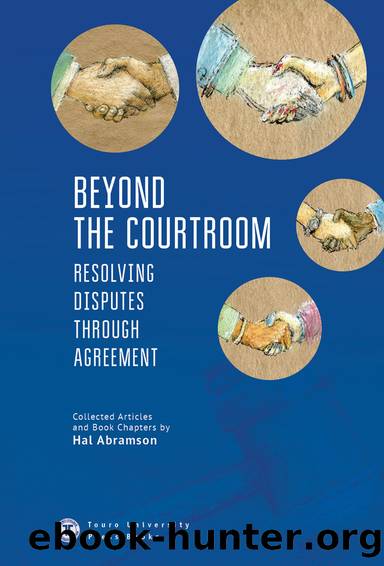Beyond the Courtroom by Hal Abramson

Author:Hal Abramson
Language: eng
Format: epub
Publisher: Academic Studies Press
Published: 2020-05-02T00:00:00+00:00
This second axis firmly demonstrates how it takes two to tangoâto create the mediation process. A mediator who is directive, even aggressively so, for instance, does not necessarily result in the parties/attorneys being deferential to the mediatorâs procedural moves or substantive direction. As the second axis clarifies, the parties/attorneys must be willing partnersâthat is, be receptive to a more directive approach for the resulting process actually to be directive.
The preferences grid illustrates the importance of the mediator and parties/attorneys sharing compatible preferences in order for the mediation process to function, and shows how these preferences shape the resulting process. Consider several combinations:
If the mediator is extremely elicitive and the parties/attorneys prefer an extremely elicitive approach, then the result can be a classically problem-solving mediation that preserves party self-determination. See point A.
If the mediator is modestly directive and the parties/attorneys prefer a modestly elicitive approach, the result can be a classically evaluative mediation where the mediator offers evaluations and the parties/attorneys give some weight to them. See point B.
If the mediator is extremely directive and the parties/attorneys prefer an extremely directive approach, the result can be a wisely directive mediation. See point C.
If the mediator is extremely elicitive and the parties/attorneys prefer an extremely directive approach, the mediation process may become dysfunctional. The parties/attorneys are likely to become quite frustrated because they are not getting the mediation service that they prefer. See point D.
Within these prototypical results, many gradations may be encountered. For example, if the mediator is evaluative and considerably directive and the parties/attorneys prefer a considerably directive approach, the result is likely to be an evaluatively directive mediation process. See point E. If the mediator is evaluatively directive and the parties/attorneys prefer primarily an elicitive approach, the mediation process also may become dysfunctional because the parties/attorneys are likely to become frustrated with the process. See point F.
In the spirit of Riskinâs caveats in his article about his âNew New Grid System,â this grid hopefully promotes understanding and discussion while avoiding being so complicated that it becomes confusing and unmanageable.37 The tension between formulating a nuanced grid and one that is easily accessible is inherent in this undertaking. I also prefer to err in favor of simplicity in order to present succinctly the encounter between distinctively cultural approaches of mediators and the preferences of parties/attorneys. The resulting grid, however, should not be blindly followed as a confident predictor of the resulting mediation process. Its value is in offering a framework for discerning and selecting the type of mediator who might formulate the sort of mediation process that may be effective with your client and the other side.
IV. IMPACT OF MEDIATORâS APPROACH ON CLIENT REPRESENTATION
After you select a mediator who is culturally trained and suitable, you need to figure out how to effectively represent your client before that sort of mediator. Knowing that the mediator is culturally trained does not radically impact your approach to representation; it only expands the possibilities of what can be achieved in the mediation. The mediator
Download
This site does not store any files on its server. We only index and link to content provided by other sites. Please contact the content providers to delete copyright contents if any and email us, we'll remove relevant links or contents immediately.
The Thirst by Nesbo Jo(6870)
Permanent Record by Edward Snowden(5791)
The Myth of the Strong Leader by Archie Brown(5450)
Spare by Prince Harry The Duke of Sussex(5131)
A Higher Loyalty: Truth, Lies, and Leadership by James Comey(4901)
Secrecy World by Jake Bernstein(4695)
Adulting by Kelly Williams Brown(4525)
The Borden Murders by Sarah Miller(4269)
Machine Learning at Scale with H2O by Gregory Keys | David Whiting(4256)
Killers of the Flower Moon by David Grann(3994)
American Kingpin by Nick Bilton(3809)
Fear by Bob Woodward(3669)
The Secret Barrister by The Secret Barrister(3655)
Future Crimes by Marc Goodman(3554)
The Last Girl by Nadia Murad(3462)
The House on Mango Street by Sandra Cisneros(3424)
Liar's Poker by Michael Lewis(3406)
The Social Psychology of Inequality by Unknown(2985)
Oathbringer (The Stormlight Archive, Book 3) by Brandon Sanderson(2984)
